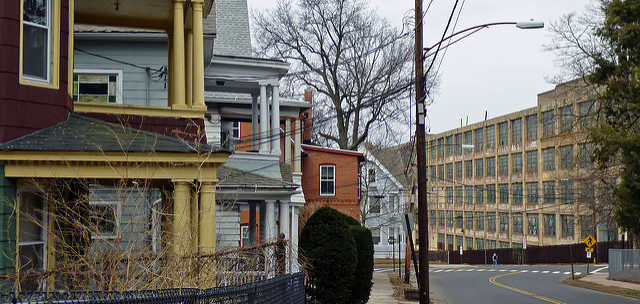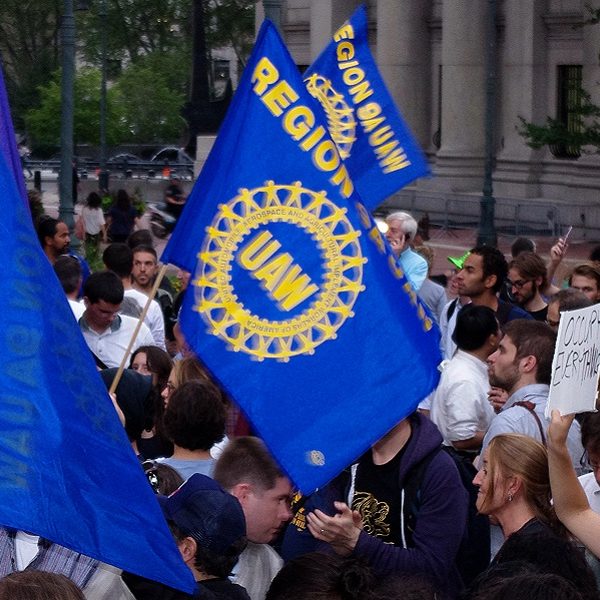Recalling the New Haven Winchester Arms Strike
On September 20th, we will publish Laura Trevelyan’s The Winchester: The Gun That Built an American Dynasty. As Trevelyan leads us through the history of the Winchester rifle, we reflect on the impact of the Winchester Repeating Arms company on our own city of New Haven, Connecticut.
Douglas W. Rae—
By 1975, Winchester Repeating Arms, the sole remaining mass manufacturer still operating in New Haven, was wallowing in economic trouble. It had already spent two decades as a minor division of a corporate conglomerate with plants in more than sixty cities, carrying out all manner of manufacturing operations producing everything from chemicals to firearms, from films and emulsions to brass castings. During periods of high military demand—wars in Korea and Vietnam—Winchester was a handsome little asset for Olin. At other times, especially after the dark shadow of peace crossed the Connecticut landscape in 1973, Winchester was a losing proposition for the parent company. Indeed, losses became a standard expectation in the late 1970s. The division reported a loss of $6.07 million in 1977, and $7.22 million the next year. These numbers could scarcely have been tolerated by a management team grounded in New Haven and concerned for its communal welfare. For a management team held accountable by a national firm, such losses could not be allowed to continue.
The company had long withheld capital investment from its antiquated New Haven plant and had begun substituting cheap castings for machined parts in 1964, making that a watershed date among gun collectors, who value “Winchester before 1964” at a premium over later models. One report, written by a former employee, gives a sense of what the work was like: “Milling was done on Lincoln machines so old that no one could recall when they were introduced. Springs were hand-wound, hand treated and hand-tested. These processes were incapable of producing dimensions within the tolerances required to manufacture interchangeable components. Units were built and rebuilt many times, creating a constant parade of firearms between test ranges and the assembly area.”
The Winchester machinists had organized themselves as Local 609 in 1955 and had achieved a series of strong contracts in the decades that followed. A divisive strike in 1969 had provoked management to cut the total size of the local workforce substantially, and Olin’s corporate headquarters had come to think of New Haven as a costly location even before serious losses began to mount in the post-Vietnam period. They focused on problems of labor productivity, while the machinists’ union focused on inadequacies of machinery and technical sophistication on the company’s part. A pivotal component of the 1969 settlement was something called Article 4, which protected workers against the imposition of production quotas. From labor’s side throughout the story: production quotas were unfair if the machinery wasn’t reliable. From management’s side in 1979: the New Haven plant would have to meet national standards of productivity per labor hour if it was to continue operation.
On July 16, 1979, one day after Local 609’s contract expired, 1,356 hourly wage-workers went on strike.
∞
Mayor Frank Logue had trouble of his own. The younger brother of Ed Logue, czar of Dick Lee’s Kremlin, Frank Logue had served two terms on the Board of Aldermen and then run a winning reform primary campaign against fellow Democrat Bart Guida (mayor, 1970–76). Challenged by the DTC’s preferred candidate in a 1977 primary, Logue had barely survived (to complicate matters, the challenger was his own police chief). In September 1979, another primary was won by DTC favorite Biagio DiLieto, while the reform vote was split between Logue and African-American insurgent Henry Parker. By October 1979, at the moment of crisis, Logue was therefore a lame duck mayor with limited political leverage. After Logue intervened to restart negotiations, the union conceded that Olin could unilaterally set production quotas but insisted that it could not actually fire workers who failed to meet them without a probationary period lasting until an arbitrator settled the individual case. Olin would agree only that such an employee should stay on the payroll for fifteen workdays. Negotiations broke down, Olin reasserted its position on replacement workers, and the early morning of Monday, October 1, became the moment of truth at which the first of these new workers would enter the plant. As Doyle recalls,
By 6:30 A.M. an estimated 600–700 strikers and their supporters clogged the streets at seven intersections near the plant and refused to allow anyone to pass…. The police made tentative efforts to clear the way but the strikers formed human walls and would not budge. The police then ceased their efforts. There was no violence and there were no arrests…. Mayor Logue had been out there since 5:30. At about 7:30 he directed [Police] Chief Morrone to secure the Olin plant and prevent persons from entering the plant between that time and 7:00 A.M. the next day, October 2. Tuesday morning, October 2, was a repeat of Monday, except this time there were 800 people blocking the streets…. When the Mayor announced that he’d decided to close the plant for a second day in order “to avoid bloodshed” the strikers and their supporters cheered him.
Next day, Logue ordered the plant closed for a third day and shared the street with DiLieto, who had defeated him in the Democratic primary weeks earlier and who was on the streets offering good will, coffee, and doughnuts to the strikers. At this point, Olin engaged Doyle and his firm (Wiggin and Dana) to seek an injunction against the mayor’s order to close the plant. In Doyle’s able hands, the law took Olin’s side, and the plant gates were open by October 9. Replacement workers were hired, and, under court injunction, the city’s police force protected their entry to the plant. The strike wore on for half a year, as “Olin was forced to halt 80 percent of its production in New Haven, resulting in $25 million-$30 million in losses, and began to make detailed plans to close the brass mill and other production facilities.”
Mayor Logue’s attempt to close down the Winchester plant symbolized the limited power of city government as clearly as any event in New Haven’s long history. The tidal wave of creative destruction that would wash away the last of the city’s industrial base could be held back neither by Local 609 nor by City Hall. On December 12, 1980, Olin formally gave up plans to continue the operation of Winchester Repeating Arms. Subsequently, some former managers of Winchester obtained financing to buy the remaining assets and to found a far smaller enterprise, U.S. Repeating Arms Company, which was itself eventually acquired by a European multinational. A workforce of several hundred still produces firearms in a new, horizontal design plant awkwardly settled in a tiny fraction of what had for so many decades been the home of Winchester Repeating Arms.
The Winchester strike was a rapid disaster wrapped in a slow catastrophe: the city’s 9,300 factory wage-earners of 1972 would dwindle to 5,700 in 1987, 3,500 in 1992, 2,804 in 1997, and an estimated 2,500 today. The tidal wave had swept away the principal basis of the New Haven economy—90 percent of the factory jobs in 1954 would be gone by 1997—in the four decades that followed Richard Lee’s first election as mayor. The tsunami was not of Lee’s making, but its impact was far greater than the sum total of redevelopment efforts—for city neighborhoods, for city retailing, for the civic fauna, for the city’s tax base, and for the community’s sense of itself. The impact was, of course, magnified and deepened by the community’s longstanding dependence on manufacturing jobs and the cash they pumped into the local economy. If centered industrial development had never happened, a far smaller city would have had far less to lose.
From City by Douglas W. Rae, published by Yale University Press in 2005. Reproduced by permission.
Douglas W. Rae is Richard Ely Professor of Management and professor of political science at Yale University. In 1990-91 he served as chief administrative officer of the city of New Haven under John Daniels, the city’s first African-American mayor.
Further Reading:


























